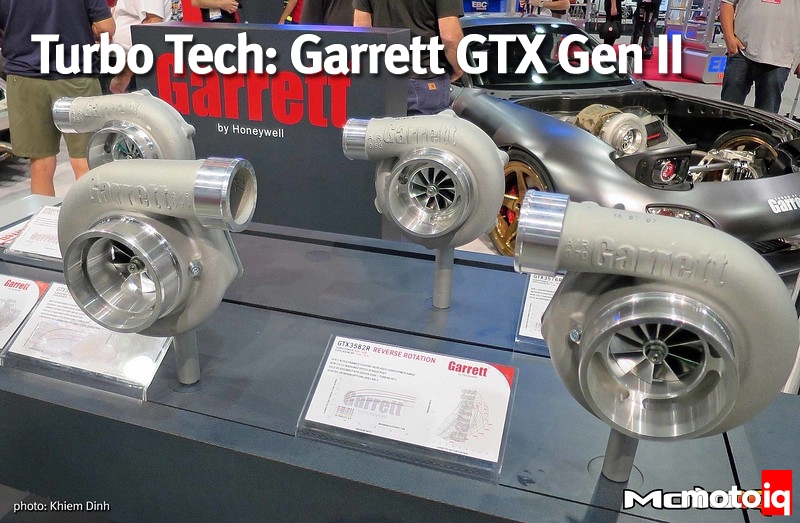,
 Step 2: Here are the points plotted on GTX3071R Gen1 (left) and Gen2 (right) compressor maps. As you can see, we cannot hit my desired 3000rpm and torque target on the Gen1 compressor as it is left of the surge line. With the wider map width of the new Gen2 compressor, we can hit my desired torque target at 3000rpm. Now let’s look at our max power point. The Gen1 compressor will operate at about 62% efficiency at a compressor speed of ~142k rpm. The Gen2 compressor is at about 67% efficiency and a speed of 135k rpm. So what does the improved compressor efficiency translate into for performance?
Step 2: Here are the points plotted on GTX3071R Gen1 (left) and Gen2 (right) compressor maps. As you can see, we cannot hit my desired 3000rpm and torque target on the Gen1 compressor as it is left of the surge line. With the wider map width of the new Gen2 compressor, we can hit my desired torque target at 3000rpm. Now let’s look at our max power point. The Gen1 compressor will operate at about 62% efficiency at a compressor speed of ~142k rpm. The Gen2 compressor is at about 67% efficiency and a speed of 135k rpm. So what does the improved compressor efficiency translate into for performance?
 Way back in our article “Compressor Efficiency and More”, we gave you the equations to calculate compressor power and temperature increase. Assuming a compressor inlet temperature of 77F (25C), the difference of 5% compressor efficiency between Gen1 and Gen2 translates into a reduction of 7hp compressor power required. The Gen2 compressor also reduces the air temp leaving the compressor by about 23F at this operating point, which means the air going into the intake manifold will be cooler. Assuming a 70% turbine efficiency, that’s a reduction of 10hp required out of the exhaust flow. Less turbine power required results in lower turbine pressure ratio, reducing back pressure and freeing up power. With our specific performance targets, we would guesstimate a 5-6hp gain in power simply going from Gen1 to Gen2 with the same compressor flow targets.
Way back in our article “Compressor Efficiency and More”, we gave you the equations to calculate compressor power and temperature increase. Assuming a compressor inlet temperature of 77F (25C), the difference of 5% compressor efficiency between Gen1 and Gen2 translates into a reduction of 7hp compressor power required. The Gen2 compressor also reduces the air temp leaving the compressor by about 23F at this operating point, which means the air going into the intake manifold will be cooler. Assuming a 70% turbine efficiency, that’s a reduction of 10hp required out of the exhaust flow. Less turbine power required results in lower turbine pressure ratio, reducing back pressure and freeing up power. With our specific performance targets, we would guesstimate a 5-6hp gain in power simply going from Gen1 to Gen2 with the same compressor flow targets.
 Here is a new big equation that allows us to calculate turbine pressure ratio based on our compressor performance targets. You will have to make assumptions on values like wastegate flow percentage (wg), turbine inlet temperature (T1T), air fuel ratio (AFR), and turbine efficiency.
Here is a new big equation that allows us to calculate turbine pressure ratio based on our compressor performance targets. You will have to make assumptions on values like wastegate flow percentage (wg), turbine inlet temperature (T1T), air fuel ratio (AFR), and turbine efficiency.

 To do the matching, you’ll need a turbine map showing turbine flow, and you’ll also have to calculate a corrected turbine mass flow value. We decided to go with the 0.83 A/R V-band turbine housing. To calculate the corrected turbine mass flow, we used the equation and correction reference values from the Wikipedia on corrected mass flow. For turbine efficiency, we assumed 70% as 72% is the maximum stated on the map. This is a big assumption, as the turbine efficiency changes as you go across the map, as we know from our article on generating turbine maps. However, as the turbo OEMs very extremely rarely show their turbine efficiency curves, we will just have to go with an assumed value. In general, smaller turbos have lower turbine efficiency and larger turbos have higher turbine efficiency. Getting the calculated turbine flow to sit on the turbine map is an iterative process; you have to adjust the wastegate flow until you get the corrected turbine mass flow to lay on the turbine map flow line, and this is why you want the excel spreadsheet. Or, you can write a Matlab program for it. Using our performance targets and assumptions, the difference in turbine pressure ratio between using Gen1 and Gen2 compressors is 2.96 vs. 2.82. Making an assumption for exhaust back pressure (P1T), we can calculate the exhaust manifold pressure (P2T). Knowing P2T, we can calculate the engine delta pressure (dP) which is the difference between intake manifold pressure and exhaust manifold pressure. The engine dP was improved from -9.5psi to -7.3psi which frees up power.
To do the matching, you’ll need a turbine map showing turbine flow, and you’ll also have to calculate a corrected turbine mass flow value. We decided to go with the 0.83 A/R V-band turbine housing. To calculate the corrected turbine mass flow, we used the equation and correction reference values from the Wikipedia on corrected mass flow. For turbine efficiency, we assumed 70% as 72% is the maximum stated on the map. This is a big assumption, as the turbine efficiency changes as you go across the map, as we know from our article on generating turbine maps. However, as the turbo OEMs very extremely rarely show their turbine efficiency curves, we will just have to go with an assumed value. In general, smaller turbos have lower turbine efficiency and larger turbos have higher turbine efficiency. Getting the calculated turbine flow to sit on the turbine map is an iterative process; you have to adjust the wastegate flow until you get the corrected turbine mass flow to lay on the turbine map flow line, and this is why you want the excel spreadsheet. Or, you can write a Matlab program for it. Using our performance targets and assumptions, the difference in turbine pressure ratio between using Gen1 and Gen2 compressors is 2.96 vs. 2.82. Making an assumption for exhaust back pressure (P1T), we can calculate the exhaust manifold pressure (P2T). Knowing P2T, we can calculate the engine delta pressure (dP) which is the difference between intake manifold pressure and exhaust manifold pressure. The engine dP was improved from -9.5psi to -7.3psi which frees up power.With this new equation knowledge under our belt, we figured we would try to see what would happen if we went from the 0.83 A/R turbine housing to the 1.01 A/R housing. It requires a bit of iteration on both the turbine and compressor sides because the engine rpm changes due to the larger 1.01 A/R housing not being able to hit the same torque at the same engine speed.
 With the larger turbine housing, we estimate the lag would increase by about 250rpm. Notice the change in compressor operating point.
With the larger turbine housing, we estimate the lag would increase by about 250rpm. Notice the change in compressor operating point.


